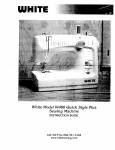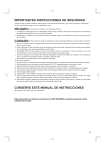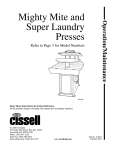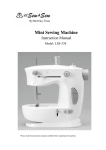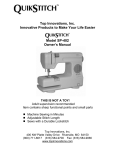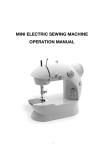Download White SEW E-Z W338 Instruction manual
Transcript
Sew E-Z Model W338 Mini Sewing Machine Instruction Manual Please read the instruction manual carefully before operating the machine. Call Toll Free 800-331-3164 1 www.whitesewing.com Introduction Thread Spindle (C) Take Up Lever (D) Thread Spool (E) Bobbin Holder (V) Bobbin Winder Spindle (T) Handwheel (K) Tension Screw (Q) Bobbin Spindle (U) Speed Button (L) ON/OFF Switch (A) Needle Clamp Screw (O) Needle Clamp (P) Needle (R) Light Button Bobbin (S) Stitch Length Adjustment Button Foot Pedal Jack (M) Presser Foot (F) AC/DC Jack (DC 6V) Bobbin compartment (I) Bobbin Holder (J) Reverse Button Bobbin Winder Handler (W) Presser Foot Lever (G) Bobbin Cover Release Button (H) Battery Compartment (B) on underside of machine 2 Parts & Accessories Foot Pedal Jack (M) AC/DC Adapter (DC 6V) Accessories Needle Threader, Tape measure, Seam ripper, Needles, Thimble, Thread, Buttons, Pins, Scissors, Bobbins, Snaps 3 Battery Installation Battery Installation 1. Caution: Make certain the POWER SWITCH is in the off position before inserting the batteries. 2. Insert (4)AA batteries in the battery slot compartment in the bottom of the machine. Be certain the batteries are in the correct polarities as marked on the machine. Then replace the battery compartment cover. 4 Threading the machine Threading the machine 1. Raise thread spindle (C) by grasping the exposed top and pulling upward until thread spindle (C) is fully extended. 2. Place thread spool (E) on the thread spindle (C) as shown. 2 3. Pull thread from the thread spool (E) on the thread spindle (C) and put it through the thread holder (1) in the direction toward front of machine. 4. Bring thread across to the 4 thread tension screw (2). Thread goes over the tension adjusting screw and must be positioned between the two washers behind the tension 5 adjusting screw(Q). This is what provides the lockstitch tension to the thread. 5. Pull thread from tension 6 adjusting screw (Q) guide through thread take up lever (D) in the direction toward front of machine (3). 6. Pull thread through thread guide (4) inserting in the direction toward the front of the machine. 7. Pull thread down to thread guide (5) and insert thread from the top downward. If necessary, lower the needle (R) to reach this guide by turning the hand wheel (K) slightly counter-clockwise (in the direction toward you) to lower the needle (R). 8. Raise the needle (R) to reach the eye by turning the hand wheel (K) slightly clockwise (in the direction away from you). Insert thread through eye (6) of the needle from the front toward the back of the machine (use threader accessory if necessary). 9. Raise the Presser Foot (F) by lifting up on the lever at the rear of machine (G). 10.Pull about 10 inches of thread through the needle (R) and lay it on the deck under the presser foot (F) running in the direction away from you. 5 1 3 Threading main unit using side bobbin (Follow steps 4-10 with these exceptions.) 1. Pull bobbin spindle (U) out from main unit. 2. Insert bobbin spindle (U) through center hole of threaded bobbin. 3. Insert bobbin spindle (U) (with bobbin attached) into bobbin holder (V). Make sure bobbin spindle (U) with bobbin are tightly secured to main unit. Note: thread main unit with side bobbin simultaneously with thread spool for a double stitch method. Side bobbin is to be used only if you’re using this particular method of stitching. Bobbin Winding and Insertion Winding the bobbin You can wind your own bobbins with thread from spools you purchase separately to have a virtually unlimited thread color selection. Match your fabrics or contrast with the thread shades of your choice. 1. Always remove the bobbin (S) from the bobbin case on the machine before you wind a new bobbin. 2. Place the thread spool (E) on the thread spindle (C). 3. Press down the bobbin winder handler (W), the bobbin winder (T) will be lifted up. 4. Take an empty bobbin. Pull the thread down from the thread (E) through the clamper (I) and thread the loose end through the small hole the bobbin to allow the small hole on the bobbin rim from the outside. 5. Leaving the loose end on the outside of the bobbin, wind the thread several turns around the INSIDE of the bobbin. 6. Place the bobbin on the bobbin winder spindle; making certain that the thread is winding onto the bobbin in a counter-clockwise direction. Adjust the bobbin to allow the small hole on the bobbin rim to line up with the spring on the bobbin winder spindle. 7. Press down the “ON” switch, the machine will start to wind the bobbin. 8. When the bobbin is full, switch off the machine. Insert the bobbin into bobbin case. 9. Lift up the bobbin winder handler. Bottom bobbin placement 1. Press the release button (H) on the rear of the machine to pop up the cover of the bobbin compartment (I). 2. Remove cover by lifting up where it has popped up at rear. 3. Place the bobbin with thread of your choice in the bobbin holder (J) leaving about 5 inches of thread extended out from the bobbin holder (J). 4. Lower presser foot (F). 5. Turn hand wheel (K) counter-clockwise (toward you). Needle (R) will go down, picking up the bobbin thread. Turn handwheel (K) until needle (R) has descended completely and then come up again to its highest raised point. Stop when needle (R) starts to go down again. 6. Raise the presser foot (F) and bring the spool thread around to the front. Pull the two threads toward the rear (away from you) and lay them under the presser foot (F). 7. Snap the bobbin compartment (I) cover down and into place. Note: Both the top and bobbin thread must be threaded correctly or the machine will not stitch properly. The machine may have come pre-threaded from the factory. Look at this threading carefully before removing it to replace the thread or bobbin with different thread. Then follow the preceding instructions to rethread. 6 Operating the Sew E-Z Rotate the handwheel to bring the needle to the highest position. Lift the presser foot and place fabric under the presser foot. Press the power switch to begin sewing. Don’t pull the fabric. Lower the presser foot. 7 Operating the Sew E-Z Controlling the Sewing Speed The machine has two speeds of sewing control. In the “H” position the switch is in, while in the “L” position the switch is out. We recommend using the slow speed at the beginning. When you become more experienced and feel confident controlling the machine, you can use the fast speed. Operating the machine without the foot pedal 1. Lift the needle (R) above the presser foot (F) by turning the had wheel (K) slightly in clockwise direction (away from you.) 2. Raise the presser foot (F) by lifting up on the rear at the machine above the Presser foot bar. 3. Position fabric to be sewn under the presser foot (F) with presser foot (F) in raised position. Make certain seam direction is toward you, aligned with the presser foot (F), with seam location directly under the needle (R). 4. Lower the presser foot (F) by releasing the presser foot lever (G) downward. 5. Rotate the hand wheel (K) in a clockwise direction two full turns to lock and start seam. Stop. 6. Select speed by pressing speed button (L) on face of machine. High speed, button is extended out. Low speed, button is in, flush with machine. Use low speed for intricate work, which requires a lot of stopping, starting and turning fabric. Use high speed for long uninterrupted seams. 7. Turn power switch (A) to “ON” position. 8. Gently guide the fabric to keep the seam straight by pressing it lightly down with your fingertips on both sides as it feeds through the presser foot (F). 9. When the seam is finished, turn switch (A) to off. 10.Raise the needle (R) above the fabric by turning the hand wheel (K) slightly in a clockwise direction. 11.Raise the presser foot (F) by lifting the presser foot lever (G). 12.Pull fabric toward you leaving about 5-10 inches of thread between the fabric and the machine. 13.Cut thread close to fabric, leaving excess thread loosely lying on the sewing deck in the direction of the presser foot (F) and toward you. 14.Begin the next seam in the same manner as above by following operating steps above. To use the with foot pedal (Follow steps 1-14 with these exceptions) 1. 2. 3. 4. Make certain machine is in “OFF” position. Plug the foot pedal jack(M) into back of machine. Turn machine on by pressing the foot pedal. Press gently on the foot Pedal to run the machine. Let up to stop. When you are finished sewing a seam, ease your foot up and off of the foot pedal. Note: The on-off switch on the machine should be in the “OFF” position when using the foot pedal. 8 Operating the Sew E-Z Adjusting thread tension Tension for maximum performance has been set and adjusted at the factory. However, if you should find that stitches are too loose, or too tight, you can adjust the stitch. 1. Loosen stitch by turning the tension screw (Q) counter-clockwise. 2. Tighten the stitch by turning tension screw (Q) clockwise. Sewing heavier fabric may require loosening the stitch. Very light fabric may require tightening the stitch. 3. Bobbin tension cannot be adjusted. Stitch length adjustment You can use the stitch length adjustment button control to change the stitch length in sewing. 1. Push the button to the left in order to get the longest stitch length. This is recommended for normal sewing. 2. By turning the button towards the right hand side, the stitch length will be reduced. 3. When the button is set to the middle point, the stich length will become zero, therefore, the fabric will not move forward. Reverse sewing Push and hold the lever down to sew in reverse. Sewing Sleeves The machine designed to allow you to sew sleeves easier. 1. Lift up the presser foot (F) and position the sleeve under the needle. Put the bobbin part of the sleeve in the gap between the platform and the base. 2. Lower the presser foot and follow the step 5-13 in the section of operating the machine on the previous page. Now you can sew the sleeve easily. 9 Changing the Needle 1. Turn the handwheel (K) clockwise to raise the needle (R) to its highest position. 2. Loosen the needle clamp screw (O) by turning it counter-clockwise (toward you). You may need to use a short slotted screwdriver or small pliers. 3. Remove the needle (R) pulling down, away from the needle clamp(P). 4. Place the new needle with the flat side facing in against the needle clamp(P). 5. Push it gently as far up as it will go, and against the needle clamp(P). 6. Tighten the needle clamp screw (O) while holding the needle (R) in place. Note: Size 90/14 sewing machine needles are recommended. 10 Precautions Set the POWER switch to OFF and don’t touch the switch when inserting batteries or plugging in or replacing the needle. Keep the unit away from children. If operated by a child, an adult shall watch the operation. Set the switch to OFF after usage and remove the batteries or pull off the plug. Don’t mix old batteries with new ones. Don’t dismantle or rebuild the unit. Don’t switch on when fabric has not been put on the unit even though top and bottom threads are ready. Troubleshooting 1. The sewing machine does not run when the power switch is pressed. •Batteries are inserted incorrectly. Insert the batteries again using the diagram provided inside the battery compartment. •Batteries are exhausted. Replace with new batteries. •Make sure the Adapter (6V,1.2A) and foot controller are connected in the corrected in the right position (-)----(----(+) 2. The sewing machine runs, but does not form stitches. •Incorrectly threaded machine. Thread machine again. •Needle is incorrectly threaded. Make sure thread is threaded from left to right. •Needle is not properly inserted. •Batteries are installed incorrectly. Check the diagram in the battery compartment and re-install. •Caution: To remove fabric after sewing, first turn the handwheel to raise the needle to the highest position. Lift the presser foot and remove the fabric. This will avoid bending the needle. 3. The machine runs slowly. •Used batteries and new batteries are used together. Replace with new batteries. •Use only AA(#3, 1.5V) batteries. 4. The sewing machine stops sewing. •Very heavy fabric or too many layers of fabric will force the sewing machine to stop. •Thread is tangle in the lower bobbin. Stop the machine. Cut the tangled threads to clear it from the machine. Re-thread both the bobbin and the needle. •Poor quality stitching: refer to “Adjusting Thread Tension” on page 9. •When new batteries are installed, the sewing machine should work for approximately 2 hours under normal sewing conditions. Remember that heavy fabric requires more power, so it will reduce the running time of the batteries. 11 ©2006 VSM Sewing Inc. White is a registered trademark. All rights reserved. 12













